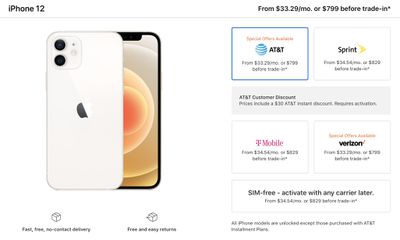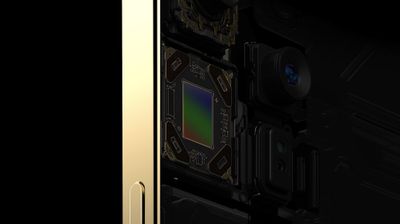Apple on Tuesday unveiled the long-awaited iPhone 12 lineup, which includes the iPhone 12, iPhone 12 mini, iPhone 12 Pro, and iPhone 12 Pro Max. The 2020 iPhones feature all-new designs with flat edges, edge-to-edge OLED displays, upgraded camera technology, and 5G connectivity.
Apple highlighted many of the features of the new devices during Tuesday's event, but there are some lesser known tidbits that you might have missed. We've rounded up some notable tidbits worth knowing before you make a purchase.
mmWave 5G Availability
If you're expecting to unbox your iPhone, set it up, and get blazing fast 5G speeds, you might be disappointed. 5G is still in the early stages of rolling out, and the fastest mmWave 5G is limited select portions of major cities, which means most people aren't going to be able to use it.
The good news is that there are two kinds of 5G networks, and the slower but still speedy sub-6GHz networks will be more widely available. There's no guarantee you'll see out of the box speed improvements, but things should improve over the course of the next year.
5G Antenna
Speaking of mmWave 5G, it is only available on iPhone 12 models sold in the United States, with iPhone 12 models in other countries supporting only sub-6GHz models. iPhones that do have mmWave support have a little antenna on the right side of the device, so they look just a bit different.

1080p FaceTime Calls Over 5G
When connected to a 5G network or WiFi, FaceTime calls are available in a higher-quality 1080p resolution. WiFi FaceTime calls at 1080p require iOS 14 to be installed as that's an iOS 14 feature.
Smart Data Mode
5G connections can drain more battery than LTE, so Apple is adding a Smart Data Mode that will switch between 5G and LTE networks as needed to preserve battery life. When you don't need 5G, such as when an app is updating in the background, your iPhone will swap over to LTE. When you do need 5G for downloading a movie, making a FaceTime call, or streaming video, the 5G connection activates.
There is, of course, a toggle so you can choose to use Smart Data Mode or have 5G activated all the time.
iPhone 12 and 12 Mini Pricing
Apple on stage advertised pricing on the iPhone 12 and 12 mini as starting at $799 and $699, respectively, but that's not quite accurate. Those are the prices with a discount from U.S. carriers, and right now, only Verizon and AT&T have the new iPhones at those prices. T-Mobile is supposedly launching some kind of similar deal on Friday, but the details haven't been announced.

If you want to buy a new iPhone 12 or 12 mini SIM-free, it's actually going to cost you an additional $30, so the iPhone 12 is really priced at $829 and the iPhone 12 mini is priced at $729.
iPhone 12 Pro and Pro Max Optical Zoom
There are different telephoto lenses built into the iPhone 12 Pro and 12 Pro Max. The iPhone 12 Pro has a 52mm telephoto lens, while the iPhone 12 Pro Max has a longer 65mm telephoto lens, which will affect portraits and other shots taken with the two phones.
The 52mm telephoto lens in the iPhone 12 Pro supports 2x optical zoom and a 4x total optical zoom range across all lenses, along with 10x maximum digital zoom.
The 65mm telephoto lens in the iPhone 12 Pro Max supports 2.5x optical zoom and a 5x total optical zoom range across all lenses, along with 12x maximum digital zoom.
Sensor-Shift Optical Image Stabilization
The Wide camera of the iPhone 12 Pro Max adopts Sensor-Shift Optical Image Stabilization, which, as the name suggests, stabilizes just the sensor of the lens, allowing for better stabilization compared to the Optical Image Stabilization that was used before and for other lenses. iPhone 12 Pro Max users can expect less camera shake and blur from movement.

Sensor-Shift Optical Image Stabilization is used in DSLRs, and this is the first time that it's been brought to an iPhone. The feature is limited to the wide-angle camera on the Pro Max and is not available for the other cameras or on the iPhone 12 Pro.
The iPhone 12 Pro uses standard Optical Image Stabilization.
15W MagSafe Charging
Apple put a ring of magnets in the iPhone 12 models and designed a MagSafe wireless charger to work with those magnets. The charger is similar in design to the Apple Watch charging puck, and it snaps right onto the new iPhones.
With the MagSafe charger, the iPhone 12 models can charge at up to 15W, which is twice as fast as the 7.5W Qi-based charging limit.
Night Mode Portraits
With the new LiDAR Scanner in the iPhone 12 Pro and 12 Pro Max, it's now possible to take Portrait shots in Night mode with the Wide camera. The LiDAR Scanner can map out the scene to separate the subject from the background while the camera captures bright colors and artful bokeh for any lighting in the image.

Speaking of Night mode, it's also available for the Ultra Wide camera for the first time so you can get some great nighttime wide-angle shots.
Night Mode for the Front-Facing Camera
Apple's new A14 chip includes a new Image Signal Processor that adds new photographic capabilities to the rear cameras and the front-facing TrueDepth camera. Night mode works with the front-facing camera for the first time so you can take neat nighttime selfies.
Deep Fusion and HDR 3 for Front-Facing Camera
The front-facing camera also supports Deep Fusion, Smart HDR 3, and Dolby Vision HDR video recording. Deep Fusion introduces improvements in color and texture in mid to low-light scenes by pulling out the best pixels from multiple exposures to make one great aggregate image.
Smart HDR 3 improves highlights, shadows, white balance, and contouring in every image for more natural lighting, and Dolby Vision HDR support allows for recording and editing Dolby Vision video.
iPhone 12 and 12 Pro Form Factor
The iPhone 12 and 12 Pro are the same 6.1-inch size as the iPhone 11, but the dimensions are slightly different. The new models are 11 percent thinner, 15 percent smaller, and 16 percent lighter than the iPhone 11.
In terms of specific dimensions, the iPhone 12 and 12 Pro measure in at 5.78 inches tall, 2.82 inches wide, and 0.29 inches thick (7.4mm). The iPhone 11 is 5.94 inches tall, 2.98 inches wide, and 0.33 inches thick (8.3mm).
If you were hoping that iPhone 11 cases would fit the new iPhone 12 models, then you're out of luck. The fit won't be quite right.
As for the iPhone 12 Pro Max and iPhone 12 mini, those are all new sizes that have no equivalent. The iPhone 12 Pro Max is the largest iPhone to date with its 6.7-inch display size, while the 5.4-inch iPhone mini is the smallest iPhone Apple has released since the 2016 iPhone SE.
More Info
iPhone 12 and 12 Pro pre-orders start at 5:00 a.m. Pacific Time on Friday, October 16, and if you're planning to pre-order, make sure to check out our time zone guide to see when pre-orders are happening in your country.
If you're still trying to decide whether to upgrade from an iPhone 11, make sure to check out our Buyer's Guide comparing the iPhone 11 to the iPhone 12, and if you're trying to decide between the iPhone 12 and the iPhone 12 Pro, we've also got a guide for that.
For more info on Apple's new devices, make sure to check out our iPhone 12 roundup and our iPhone 12 Pro roundup.

























